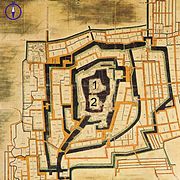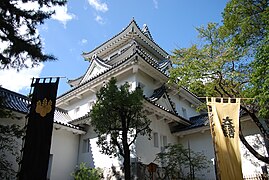Ōgaki Castle
| Ōgaki Castle | ||
|---|---|---|
|
Ōgaki Castle |
||
| Castle type : | Hirajiro (Lower Castle) | |
| Conservation status: | Partly reconstructed | |
| Place: | Ōgaki | |
| Geographical location | 35 ° 21 '43 " N , 136 ° 36' 58" E | |
|
|
||
The Ōgaki Castle ( Japanese 大 垣 城 , Ōgaki-jō ) is located in the city of Ōgaki , Gifu Prefecture . Most recently, the main branch of the Toda family resided there with an income of 100,000 koku .
Lords of the castle in the Edo period
- From 1601 Ishikawa Yasumichi and descendants with an income of 50,000 koku.
- From 1615 the Matsudaira (Hisamatsu) with 50,000 Koku.
- From 1624 the okabe with 50,000 koku.
- From 1633 again the Matsudaira (Hisamatsu) with 60,000 Koku.
- From 1635 Toda Ujikane and offspring with 100,000 Koku.
The attachment
In the Sengoku period , the Mino-Saitō ruled the surrounding area from Ōgaki until Oda Nobunaga managed to take over the castle and the area. After Nobunaga's death, Toyotomi Hideyoshi took over the castle, which was used by his relatives and important leaders, most recently by the Itō . In the Battle of Sekigahara in 1600, Ōgaki Castle, just ten kilometers from the battlefield , served as a base for Ishida Mitsunari , one of Hideyoshi supporters. After his death at the end of the battle, Ishikawa Yasumichi ( 石川 康 通 ; 1554-1607) received the castle. Under him and his descendants Ienari ( 家 成 ; 1572–1650) and Tadafusa ( 忠 総 ) the castle got its final shape through restoration and expansion.
The Ōgaki castle, surrounded by branches of the Ibi-kawa ( 揖 斐川 ), has the classic shape of a low castle. In the center is the Hommaru, south of it the Ni-no-maru, together surrounded by a ditch up to 70 m wide. The wider area is determined by the San-no-maru and other castles, which in turn are surrounded by an outer moat, the Sōgamae ( 総 構 ), 4 kilometers in length. The Hommaru, or the inner castle, had a four-story castle tower, a three-story watchtower and two two-story, later four two-story, watchtowers. The Ni-no-maru was protected by a three-story watchtower. There was also the residence, the Goten ( 御 殿 ).
At the beginning of the Meiji period , after 1868, the castle was demolished. However, the castle tower and some corner towers have been preserved. These structures were then lost to bombing during World War II . The castle grounds were largely integrated into the city, part of which was converted into a park. In 1959 the castle tower was rebuilt, in 1985 the Ushitorasumi watchtower and the Inuisumi watchtower were rebuilt.
photos
Plan from the Edo period
Remarks
- ↑ Ushitora- ( 艮 or 丑 寅 ) -sumi is the northeast corner after the Twelve Earth Branches , Inui- ( 乾 or 戌 亥 ) -sumi, the northwest corner of the castle, with sumi ( 隅 ) = corner.
-
↑ The flag on the right shows the coat of arms of Ishida Mitsunari, namely
 .
.
literature
- Yasutsune Owada: Ogaki-jo . In: Masayuki Miura (ed.): Shiro to jinya. Tokoku-hen . Gakken, 2006, ISBN 978-4-05-604378-5 .






